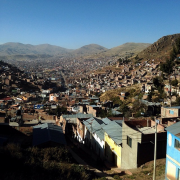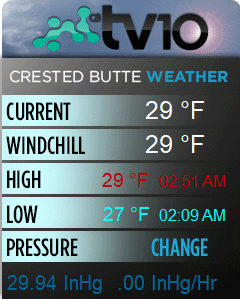Ed Dujardin has taken a leave of absence from the Crested Butte community this summer on a magnificent journey to South America. While this legendary babysitter and waitron at the Secret Stash will be missed until his return at the end of September, you can be step by step with him and vicariously live through his blog posts right here on West Elk Project. Enjoy.
Left photo: The city of Puno.
May 17
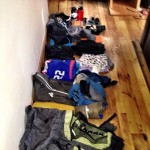
All my belongings until I add ski stuff.
The idea for a grand South American adventure first occurred while I was traveling in New Zealand in September 2011, which happened to be the same time as the Rugby World Cup. The energy, passion, and excitement throughout the country was almost tangible. You could feel it everywhere you went, and despite not knowing much about rugby, I was hooked. Even after returning to Colorado, I found myself setting a3:30 am alarm to watch the New Zealand vs France final, in which New Zealand narrowly held on to win, much to the delight of my new Kiwi friends. So I set my sights on a similar event for a sport I actually know and play, the 2014 soccer World Cup in Brazil.
In addition to being an avid soccer fan, during college I studied political science and history with a Latin American emphasis. And though I’ve been to Chile before, the purpose of my trip was to ski. I left that trip with feeling somewhat empty, having seen nothing of Latin America besides the ski slopes. Don’t get me wrong, skiing in Chile was incredible, but I ski every day I can all winter back home. I plan to ski, this trip, but not until the end (I’m still looking for someone to mule my skis down to the Andes for me, so if you plan on going please let me know!).
So the grand romantic plan is this. Fly into Lima. Do the Peru tourist thing (Machu Picchu, Lake Titicaca, and everything along the way). From there, cross into Bolivia. Check out La Paz, Potosi, the salt flats, and Santa Cruz before bussing to Paraguay. Spend a few days in Asuncion before bussing to the Brazil boarder, crossing at the famed Iguazu falls. From there, check out Foz de Iguazu, get to Rio de Janiero somehow, then head south along the coast, stopping in São Paulo, and Porto Allegre. I’m hoping to catch a France game (all the USA group stage games are in the north, and while USA soccer is stronger than it’s ever been, we are in the so called “group of death” so I don’t see us getting out of the group stage.) After Brazil, I plan to head to Uruguay, a country I know nothing about. I hope to cross into Argentina via a ferry from Montevideo. I want to spend time in Buenos Aires before heading west to the Andes, via Cordoba, eventually ending up in Chile. Snow conditions will dictate my moves from there. I plan on competing in the Freeride World Qualifier ski competition (wherever that may be). My ticket home is set for September 29th, but I can change that three weeks in advance for free, so I have options. These are just tentative plans though. I really have no agenda, and except for the Peru portion, I am traveling alone, so I have the freedom to be spontaneous. My Spanish background consists of audio tapes I listened to during my shuttle driving job this past summer, so it’s not good at all. Hopefully my French background helps. Wherever I end up, I do know that it will be an amazing and eye opening adventure.
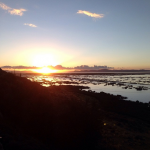
Lake Titicaca at sunrise.
May 22
My trip to South America began with a flight to my home state of New Jersey to meet up with family that had decided they wanted to join me for the Peru portion of my trip. The eight hour flight from Newark to Lima was super easy, and Peruvian Customs was a breeze. Unfortunately, I did not get to explore Lima, as our flight south to Juliaca (the main airport near Lake Titicaca was the next morning). Apparently Lima is worth a few days, though due to time constraints for my little brother Amaury, we had to move on.
After an hour flight, we arrived in Juliaca, a seedy and somewhat depressing city who’s proximity to the Bolivian boarder makes it a prime location for knockoff goods. We got on the Pan-American highway towards Puno, a busy city on the shore of Lake Titicaca. On the way, we stopped at Sillustani, an archeological site that has served as sacred burial grounds for four different indigenous cultures dating back to 800 bc. We toured around the burial towers, some over 25 feet high, of various styles corresponding to the culture it was erected in, situated on the shores of Lake Umayo. From there we continued to Puno, where we would stay for two nights.
We awoke the next day to a beautiful sunrise on Lake Titicaca. The enormity of the lake is impressive. It is easy to see why it was ancient cradle of pre Incan and Incan civilization, that, prior to Pizarro’s arrival, supported between 10-15 million people. At seven, we boarded a boat to the floating islands of Uros. The islands were created by an Amazonian people who migrated to the lake, but had to seek safety from the local people, and subsequently lived on large reed boats, until they created actual floating islands made of reeds. In the last thirty years the floating islands have become quite touristy, but they continue to live there. From there we boated to a peninsula about two hours away, where we rented kayaks. From the peninsula we got to see the expanse of the lake, and the shores of Bolivia in the distance.
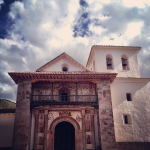
Inside is the Sistene Chapel of the Andes.
The next day we began the road to Cusco, first traveling back through Juliaca and across the state line into Cusco state at La Raya. It was a welcome change of scenery from the Altiplano which, despite being over 12000 feet, was relatively flat and dry. Along the way we stopped at Racchi ruins, formerly the “Temple of the God Wiracocha.” Like all Inca temples, Racchi served multiple purposes. It’s positioning was used to tell time and predict weather. It had massive food storage capability, as the weather phenomenon El Niño has an enormous impact on Peru’s microclimate. It also served as a military outpost for Cusco.
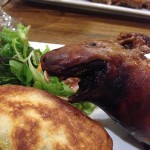
Fried Guinea Pig. Yum.
For our final stop before Cusco, we visited Andahuaylillas, home of a church known as the Sistine Chapel of the Andes. The church, located in a very small town, was magnificent. If religious history is your thing, it is a must see. The interior (where photos are not allowed) is full of incredible fresco murals and a ridiculous amount of gold. It was interesting to note the mixture of Incan influence in this Catholic church. Just google Andahuaylillas and you’ll understand.
We arrived in Cusco in time to enjoy the final hours of daylight. Despite being a mega tourist trap, it is incredible. We had time to check out the markets, see the Basilica Cathedral, and enjoy the most unique dinner of our trip so far at Deva. Amaury and I ate guinea pig, which actually isn’t so bad. We got to go back into the kitchen to see it being made, which was awesome. Amaury had it fried, while mine was baked. We liked fried more.
Tomorrow, we are taking a train to Machu Picchu. That will be followed by a three day hike in the Sacred Valley. Look for a blog post then. Follow along on Instagram with the hashtag, #spedgoestosouthamerica and @spedwardstomps. Hope all is well back home!


